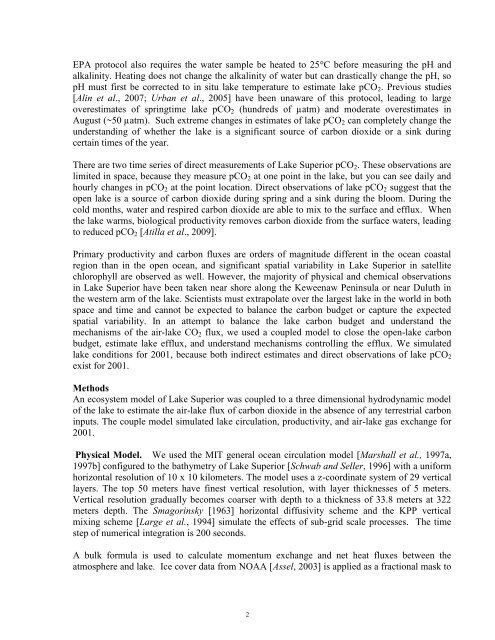Space Grant Consortium - University of Wisconsin - Green Bay
Space Grant Consortium - University of Wisconsin - Green Bay
Space Grant Consortium - University of Wisconsin - Green Bay
You also want an ePaper? Increase the reach of your titles
YUMPU automatically turns print PDFs into web optimized ePapers that Google loves.
EPA protocol also requires the water sample be heated to 25 C before measuring the pH and<br />
alkalinity. Heating does not change the alkalinity <strong>of</strong> water but can drastically change the pH, so<br />
pH must first be corrected to in situ lake temperature to estimate lake pCO2. Previous studies<br />
[Alin et al., 2007; Urban et al., 2005] have been unaware <strong>of</strong> this protocol, leading to large<br />
overestimates <strong>of</strong> springtime lake pCO2 (hundreds <strong>of</strong> µatm) and moderate overestimates in<br />
August (~50 µatm). Such extreme changes in estimates <strong>of</strong> lake pCO2 can completely change the<br />
understanding <strong>of</strong> whether the lake is a significant source <strong>of</strong> carbon dioxide or a sink during<br />
certain times <strong>of</strong> the year.<br />
There are two time series <strong>of</strong> direct measurements <strong>of</strong> Lake Superior pCO2. These observations are<br />
limited in space, because they measure pCO2 at one point in the lake, but you can see daily and<br />
hourly changes in pCO2 at the point location. Direct observations <strong>of</strong> lake pCO2 suggest that the<br />
open lake is a source <strong>of</strong> carbon dioxide during spring and a sink during the bloom. During the<br />
cold months, water and respired carbon dioxide are able to mix to the surface and efflux. When<br />
the lake warms, biological productivity removes carbon dioxide from the surface waters, leading<br />
to reduced pCO2 [Atilla et al., 2009].<br />
Primary productivity and carbon fluxes are orders <strong>of</strong> magnitude different in the ocean coastal<br />
region than in the open ocean, and significant spatial variability in Lake Superior in satellite<br />
chlorophyll are observed as well. However, the majority <strong>of</strong> physical and chemical observations<br />
in Lake Superior have been taken near shore along the Keweenaw Peninsula or near Duluth in<br />
the western arm <strong>of</strong> the lake. Scientists must extrapolate over the largest lake in the world in both<br />
space and time and cannot be expected to balance the carbon budget or capture the expected<br />
spatial variability. In an attempt to balance the lake carbon budget and understand the<br />
mechanisms <strong>of</strong> the air-lake CO2 flux, we used a coupled model to close the open-lake carbon<br />
budget, estimate lake efflux, and understand mechanisms controlling the efflux. We simulated<br />
lake conditions for 2001, because both indirect estimates and direct observations <strong>of</strong> lake pCO2<br />
exist for 2001.<br />
Methods<br />
An ecosystem model <strong>of</strong> Lake Superior was coupled to a three dimensional hydrodynamic model<br />
<strong>of</strong> the lake to estimate the air-lake flux <strong>of</strong> carbon dioxide in the absence <strong>of</strong> any terrestrial carbon<br />
inputs. The couple model simulated lake circulation, productivity, and air-lake gas exchange for<br />
2001.<br />
Physical Model. We used the MIT general ocean circulation model [Marshall et al., 1997a,<br />
1997b] configured to the bathymetry <strong>of</strong> Lake Superior [Schwab and Seller, 1996] with a uniform<br />
horizontal resolution <strong>of</strong> 10 x 10 kilometers. The model uses a z-coordinate system <strong>of</strong> 29 vertical<br />
layers. The top 50 meters have finest vertical resolution, with layer thicknesses <strong>of</strong> 5 meters.<br />
Vertical resolution gradually becomes coarser with depth to a thickness <strong>of</strong> 33.8 meters at 322<br />
meters depth. The Smagorinsky [1963] horizontal diffusivity scheme and the KPP vertical<br />
mixing scheme [Large et al., 1994] simulate the effects <strong>of</strong> sub-grid scale processes. The time<br />
step <strong>of</strong> numerical integration is 200 seconds.<br />
A bulk formula is used to calculate momentum exchange and net heat fluxes between the<br />
atmosphere and lake. Ice cover data from NOAA [Assel, 2003] is applied as a fractional mask to<br />
2

















